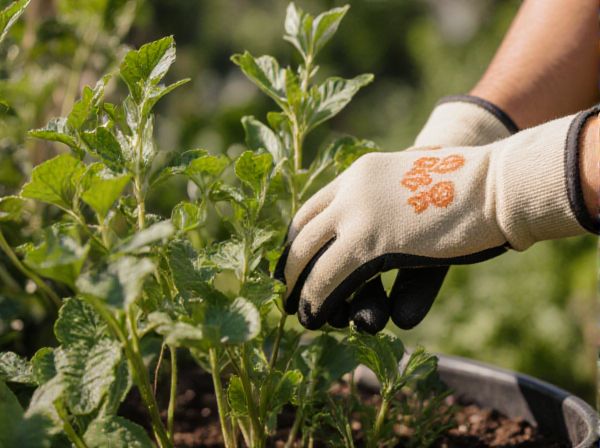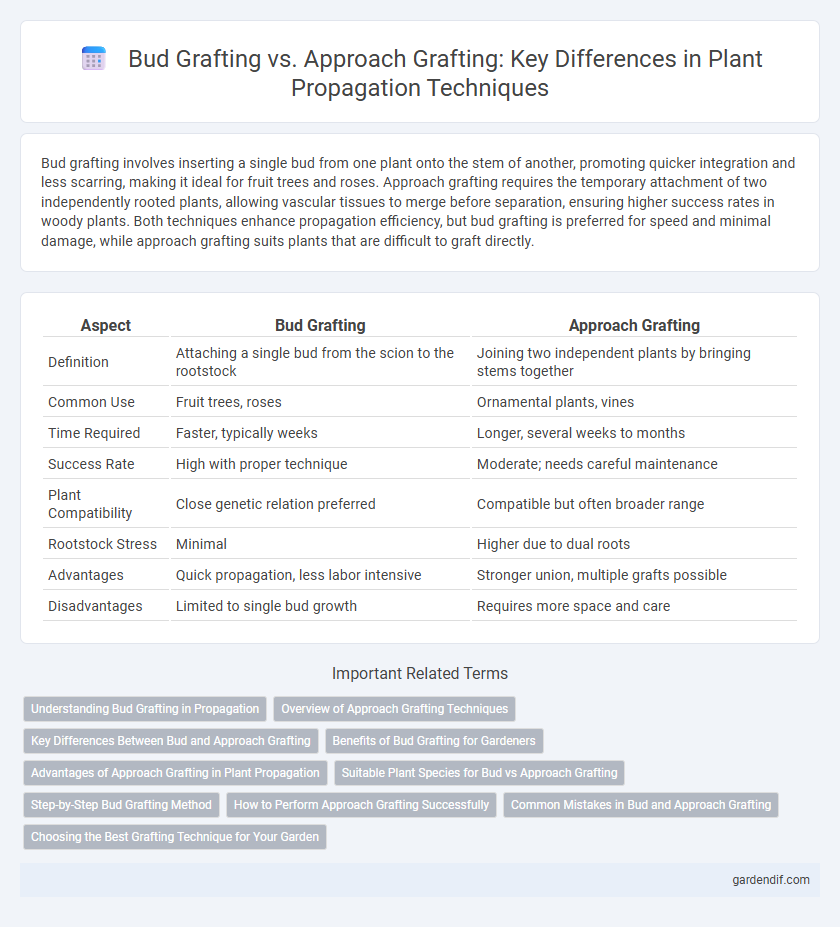
Bud grafting vs approach grafting Illustration
Bud grafting involves inserting a single bud from one plant onto the stem of another, promoting quicker integration and less scarring, making it ideal for fruit trees and roses. Approach grafting requires the temporary attachment of two independently rooted plants, allowing vascular tissues to merge before separation, ensuring higher success rates in woody plants. Both techniques enhance propagation efficiency, but bud grafting is preferred for speed and minimal damage, while approach grafting suits plants that are difficult to graft directly.
Table of Comparison
| Aspect | Bud Grafting | Approach Grafting |
|---|---|---|
| Definition | Attaching a single bud from the scion to the rootstock | Joining two independent plants by bringing stems together |
| Common Use | Fruit trees, roses | Ornamental plants, vines |
| Time Required | Faster, typically weeks | Longer, several weeks to months |
| Success Rate | High with proper technique | Moderate; needs careful maintenance |
| Plant Compatibility | Close genetic relation preferred | Compatible but often broader range |
| Rootstock Stress | Minimal | Higher due to dual roots |
| Advantages | Quick propagation, less labor intensive | Stronger union, multiple grafts possible |
| Disadvantages | Limited to single bud growth | Requires more space and care |
Understanding Bud Grafting in Propagation
Bud grafting involves inserting a single bud from a desired plant variety onto the rootstock, which promotes faster union and quicker fruiting compared to other methods. This technique is particularly effective for woody plants, allowing precise genetic propagation with minimal scarring. Understanding bud grafting aids in selecting the appropriate timing and handling to ensure successful propagation outcomes.
Overview of Approach Grafting Techniques
Approach grafting involves joining two independent plants by bringing their stems or branches into contact, allowing them to fuse and grow as one. Common techniques include tongue grafting and saddle grafting, which create complementary cuts on both plants to improve cambium contact and successful union. This method enables the retention of both root systems, enhancing plant vigor and stability during propagation.
Key Differences Between Bud and Approach Grafting
Bud grafting involves inserting a single bud from the desired plant onto the rootstock, enabling faster healing and growth, while approach grafting joins the stems of two independent plants, allowing both root systems to remain intact during union. Bud grafting is more suitable for woody plants with active cambium, whereas approach grafting is preferred for plants difficult to graft by other methods due to its higher success rate. The key difference lies in the number of buds used and the timing of vascular connection, with bud grafting requiring less time for graft union development compared to the approach technique.
Benefits of Bud Grafting for Gardeners
Bud grafting offers gardeners precise control over plant variety and faster fruit production compared to approach grafting. This method requires less space and fewer resources, making it ideal for small gardens or limited environments. Bud grafting also promotes quicker union and higher success rates, enabling more efficient plant propagation.
Advantages of Approach Grafting in Plant Propagation
Approach grafting offers superior success rates in plant propagation due to the simultaneous development of vascular connections while both plants remain rooted, ensuring stronger graft unions. This method reduces transplant shock and enhances nutrient flow, leading to faster growth compared to bud grafting. Additionally, approach grafting allows grafting between plants of more diverse sizes and species, increasing versatility in propagation practices.
Suitable Plant Species for Bud vs Approach Grafting
Bud grafting is particularly suitable for fruit trees like apples, pears, and stone fruits, where a single bud can be grafted onto rootstock to propagate desired traits efficiently. Approach grafting works well with woody plants such as roses, grapes, and certain ornamentals, allowing two independent plants to be joined while maintaining their own root systems temporarily. The choice depends on species compatibility, growth habits, and the success rates associated with each grafting method.
Step-by-Step Bud Grafting Method
Bud grafting involves carefully selecting a healthy bud from the desired plant, making a precise T-shaped cut on the rootstock bark, and inserting the bud into this incision before securely wrapping it to promote healing. Throughout the process, maintaining a clean grafting knife and ensuring the cambium layers of both bud and rootstock align is critical for successful tissue fusion and nutrient exchange. Monitoring for bud swelling and removing the wrap after two to three weeks encourages vigorous shoot development, making bud grafting a reliable propagation technique compared to approach grafting.
How to Perform Approach Grafting Successfully
Performing approach grafting successfully involves selecting healthy, compatible plants and ensuring both stems are positioned closely without causing damage. Secure the graft union with grafting tape or clips to facilitate vascular connection and maintain moisture by wrapping the union area with a damp cloth or plastic. Monitor the graft site regularly for signs of growth or infection, and once the graft has formed a strong union, carefully separate the new plant from the rootstock.
Common Mistakes in Bud and Approach Grafting
Common mistakes in bud grafting include improper selection of healthy rootstock and scion, incorrect timing during the growing season, and failure to maintain adequate moisture levels, resulting in poor bud union and graft failure. Approach grafting errors often involve inadequate alignment of vascular cambium layers, insufficient bark removal causing poor contact, and lack of secure binding, which leads to weak graft unions and decreased survival rates. Ensuring precise technique and careful monitoring during both grafting methods significantly improves success rates in propagation.
Choosing the Best Grafting Technique for Your Garden
Bud grafting offers a precise and efficient method for propagating fruit trees, especially when limited scion wood is available, by inserting a single bud onto the rootstock. Approach grafting provides robust vascular union and higher success rates by joining two independent plants before severing the original stems, making it ideal for difficult-to-graft species. Selecting the best grafting technique depends on plant type, timing, and desired growth speed, with bud grafting preferred for delicate or seasonal propagation and approach grafting suited for preserving plant vigor and ensuring strong grafts.
Bud grafting vs approach grafting Infographic

 gardendif.com
gardendif.com